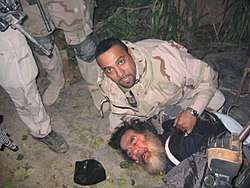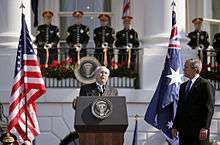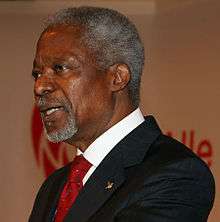Operation Red Dawn
Operation Red Dawn was an American military operation conducted on 13 December 2003 in the town of ad-Dawr, Iraq, near Tikrit, that led to the capture of Iraqi dictator Saddam Hussein. The operation was named after the 1984 film Red Dawn.[1] The mission was executed by joint operations Task Force 121—an elite and covert joint special operations team, supported by the 1st Brigade Combat Team (led by Col. James Hickey) of the 4th Infantry Division, commanded by Maj. Gen. Raymond Odierno.
| Operation Red Dawn | |||||||
|---|---|---|---|---|---|---|---|
| Part of the Iraq War | |||||||
 Samir, a 34-year-old Iraqi-American military interpreter who helped find Saddam and pull him from his hideaway in December 2003. | |||||||
| |||||||
| Belligerents | |||||||
|
|
| ||||||
| Commanders and leaders | |||||||
|
|
| ||||||
| Units involved | |||||||
| |||||||
| Strength | |||||||
| 600 | 3 | ||||||
| Casualties and losses | |||||||
| None | 3 captured | ||||||
They searched two sites, "Wolverine 1" and "Wolverine 2", outside the town of ad-Dawr, but did not find Hussein. A continued search between the two sites found Hussein hiding in a "spider hole" at 20:30 hrs local Iraqi time. Hussein did not resist capture.[2]
Background
Hussein disappeared from public view soon after the 2003 invasion of Iraq. The American military labelled him "High Value Target Number One" (HVT1) and began one of the largest manhunts in history.[3]
Between July and December 2003, JSOC's Task Force 121 carried out twelve unsuccessful raids to find Saddam Hussein, together with 600 other operations against targets, including 300 interrogations. On 1 December 2003, a former driver divulged the name Muhammed Ibrahim Omar al-Musslit, Saddam's right-hand man, known to TF 121 as "the source" or "the fatman." Over the next two weeks, nearly 40 members of his family were interrogated to ascertain his location. On 12 December 2003, a raid on a house in Baghdad that was being used as an insurgent headquarters captured al-Musslit. Early the next morning he revealed where Saddam may be found.[4] This intelligence and other intelligence from detained former members of the Ba'ath Party, supported by signals intelligence from the ISA, finally pinpointed Hussein at a remote farm compound south of Tikrit.[5]
Operation
Operation Red Dawn was launched after gaining actionable intelligence identifying two likely locations of Saddam's whereabouts code-named Wolverine 1 and Wolverine 2, near the town of ad-Dawr. C squadron Delta Force, ISA operators under Task Force 121 and the First Brigade Combat team of the 4th ID, conducted the operation.[5] The operation was named after the 1984 film of the same name starring Patrick Swayze. The site names of "Wolverine 1" and "Wolverine 2" are also a reference to the American insurgent group in the movie, The Wolverines. The Forces involved in the operation consisted of approximately 600 soldiers including cavalry, artillery, aviation, engineer and special operations forces.
The forces cleared the two objectives but initially did not find the target. Then, as the operators were finishing and the helicopters called in to extract them, one assaulter kicked a piece of flooring to one side, exposing a spider hole; he prepared to throw a fragmentation grenade into it – in case it led to an insurgent tunnel system, when suddenly Hussein appeared. The Delta operator struck him with the stock of his M4 Carbine and disarmed him of a Glock 18C.[5]
Hussein surrendered and offered no real resistance; he was exfiltrated by a MH-6 Little Bird from the 160th SOAR to the Tikrit Mission Support Site where he was properly identified. After proper identification, he was then taken by an MH-60K Blackhawk helicopter from 160th SOAR from Tikrit to Baghdad and into custody at Baghdad International Airport. Along with the Glock, an AK-47 and $750,000 in US bank notes were recovered from the spider hole.[5]
Two other individuals were also detained. There were no casualties in the operation.
Reactions
International reactions
Middle East

![]()
![]()
![]()
![]()
![]()
![]()
![]()
![]()
![]()
Asia
![]()
![]()
![]()

![]()
Sinha, in his brief conversation with Powell, merely expressed hope that such developments would contribute to the stabilization of Iraq. Powell told Sinha that the capture would bring "a change in the existing situation and lead to greater respect for the Iraqi Governing Council."
![]()
![]()
In Japan, Chief Cabinet Secretary Yasuo Fukuda agreed the arrest was "great news," but cautioned it would not necessarily lead to peace.
"The problem, however, is terrorism. I don't think the arrest of Saddam Hussein can stop all terror attacks," Fukuda said.
![]()
Iraqis should "be given the right to decide on the manner and procedure of bringing Saddam Hussein to face justice," said Prime Minister Abdullah Ahmad Badawi, head of the Non-Aligned Movement. Foreign Minister Syed Hamid Albar expressed hope that the capture of Saddam Hussein would contribute towards bringing peace and stability in Iraq and the surrounding region and stated that the United Nations should now play a bigger role in achieving this objective. "With peace and stability in Iraq, we hope that an Iraqi government representing the free and independent Iraqi people could be set up to start the reconstruction process of that nationfor the benefit of its people," he said. He said the views and inputs of the Iraqis should be taken into account in deciding whatever action would be initiated against Saddam. Former Prime Minister Mahathir Mohammed urged a fair trial for Saddam Hussein.[9]
![]()
![]()
![]()
![]()
Europe
![]()
![]()
![]()
![]()
![]()
![]()
![]()
North America
![]()
- President George W. Bush said that Saddam would "face the justice he denied to millions. For the Ba'athist holdouts responsible for the violence, there will be no return to the corrupt power and privilege they once held". [12]
- Secretary of Defense Donald Rumsfeld stated, "Here was a man who was photographed hundreds of times shooting off rifles and showing how tough he was, and in fact, he wasn't very tough, he was cowering in a hole in the ground, and had a pistol and didn't use it, and certainly did not put up any fight at all. I think that ... he resulted in the death of an awful lot of Iraqi people, In the last analysis, he seemed not terribly brave." Rumsfeld said the U.S. has not decided whether to classify Saddam Hussein as a prisoner of war, but that the U.S. would abide the Geneva Conventions. More than 24 hours after his capture, the uncooperative Saddam Hussein had said little in his interrogation. [13]
Oceania
Australia

Australia's Prime Minister John Howard reacted to the news happily. He said the Iraqi people could breathe a sigh of relief now that the former dictator was no longer at large. The Australian Broadcasting Corporation interviewed him.[14]
New Zealand
New Zealand Prime Minister Helen Clark reiterated the New Zealand legislature's opposition to capital punishment, with such opposition extending to the treatment of Saddam Hussein.
Africa
Kenya
People Daily newspaper
- The capture of deposed Iraq leader Saddam Hussein is, no doubt, a major victory for the United States and the coalition of the willing, chief among which is Britain. The curtain has now fallen on one of the world's most ruthless and intriguing leaders.
International organizations
Arab League
Secretary General Amr Mussa said the Iraqi people should "decide the fate of the old regime and its old leaders," alluding to the discovery of mass graves after Saddam's fall during the US invasion in April.
International Committee of the Red Cross
The International Committee of the Red Cross says the US-led coalition in Iraq had given the agency the "green light" to visit Saddam Hussein, the former Iraqi leader.
Red Cross spokesman Florian Westphal confirmed that ICRC visits to the captured Iraqi leader would go ahead according to international rules governing the detention of all prisoners of war. He said discussions are under way as to how and where those visits would take place.
United Nations
A spokesman for Kofi Annan, United Nations Secretary General, said the capture "offers an opportunity to give fresh impetus to the search for peace and stability in Iraq".

Former U.N. chief weapons inspector Hans Blix said the Allied Coalition might ask Saddam Hussein meaningful questions about Iraq's nuclear, biological, and chemical weapons programmes, "He ought to know quite a lot, and be able to tell the story; we all want to get to the bottom of the barrel".
POW status
A Pentagon spokesman said he was given the status as he was the leader of the "old regime's military forces."
The spokesman, Major Michael Shavers, said Saddam, captured by US troops in December, was entitled to all the rights under the Geneva Conventions. The International Committee of the Red Cross had asked to visit the former Iraqi leader as soon as possible. The US spokesman did not give further details about Saddam Hussein's conditions of detention.
POW status for Saddam Hussein meant that the former Iraqi leader would be eligible to stand trial for war crimes.
There was controversy over TV pictures which showed Saddam Hussein undergoing a medical examination after his capture - footage regarded by some as a failure to protect him from public curiosity. A leading Vatican clergyman described the scenes as Saddam being "treated like a cow," and some sections of the Arab world were deeply offended by them. The US maintains that the pictures were shown to demonstrate to the Iraqi people that they no longer had anything to fear.
A senior British official said Saddam - who was being held at an undisclosed location and interrogated by the Central Intelligence Agency (CIA) - was still refusing to co-operate with his captors, but the former president's capture the previous month was yielding results "far greater than we expected," the official told reporters on condition of anonymity.
The US-led coalition had used documents found with the ex-leader to mount operations against Saddam loyalists, the official said.
References
- "Red Dawn imitated art". USA Today. 17 December 2003. Retrieved 31 December 2015.
- Freeman, Colin (16 December 2003). "From lavish palaces to a hole in the ground". The Scotsman. Archived from the original on 16 October 2007. Retrieved 19 May 2011.
- Younge, Gary (15 December 2003). "In a hole in the ground, luck runs out for High Value Target Number One". The Guardian. Retrieved 30 December 2015.
- Lewis, John E. (2014). The Mammoth Book of Covert Ops: True Stories of Covert Military Operations, from the Bay of Pigs to the Death of Osama bin Laden. London, UK: Robinson. ISBN 978-1-78033-785-2.
- Neville, Leigh (2015). Special Forces in the War on Terror (General Military). Oxford, UK: Osprey Publishing. pp. 195–197. ISBN 978-1-47280-790-8.
- Brokaw, Tom (15 December 2003). "Afghanistan's Hamid Karzai: Will Saddam's capture help find Osama bin Laden?". NBC News. Retrieved 9 July 2018.
- Assadi, Mohammed (14 December 2003). "Palestinians mark 'black day' of Saddam capture". Reuters. Retrieved 9 July 2018 – via Tom Gross Media.
- "Capture of former Iraqi leader Saddam Hussein: World reaction in quotes". BBC News. 15 December 2003. Retrieved 9 July 2018.
- "Malaysia: Former Prime Minister Urges Fair Trial for Saddam". Adnki.com.
- John Paul II (13 January 2003). "Address to the Diplomatic Corps". Vatican City. Retrieved 7 February 2007.
- "Martin sure Saddam will get just trial". CBC News. 14 December 2003. Archived from the original on 6 November 2012. Retrieved 28 June 2018.
- "President Bush Addresses Nation on the Capture of Saddam Hussein Remarks by the President on the Capture of Saddam Hussein The Cabinet Room". georgewbush-whitehouse.archives.gov. 14 December 2003. Retrieved 21 May 2020.
- "Exclusive: Rumsfeld On Saddam". www.cbsnews.com. 14 December 2003. Retrieved 4 July 2020.
- "Reaction to the capture". The Guardian. 14 December 2003. Retrieved 9 July 2018.
External links
- "How Saddam Hussein was captured". BBC News Online. 15 December 2003. Retrieved 31 December 2015.
- Wilson, Chris (22 February 2010). "Searching for Saddam". Slate. Retrieved 30 December 2015.
- "Operation RED DAWN nets Saddam Hussein". U.S. Army. 6 December 2013. Retrieved 31 December 2015.
.jpg)